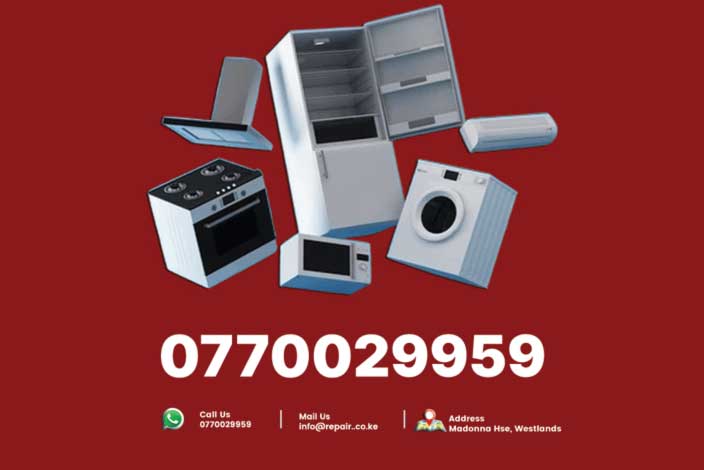A washing machine’s door or lid lock is a critical safety feature that prevents the machine from operating when the door is open, ensuring user safety and proper function. When the door or lid fails to lock, the washing machine may not start, or it may stop mid-cycle, leaving you with a pile of unwashed laundry. This article explores the common reasons why a washing machine door or lid may not lock and provides practical steps to diagnose and fix the issue, based on expertise from Repair.co.ke.
Common Causes of a Washing Machine Door or Lid Not Locking
Several issues can prevent a washing machine’s door or lid from locking properly. Understanding these causes is the first step toward resolving the problem.
-
Faulty Door Latch or Lock Mechanism
The door latch or lock assembly is responsible for securing the door during operation. Over time, wear and tear, debris buildup, or mechanical failure can prevent the latch from engaging properly. For top-loading machines, the lid switch serves a similar function and may fail due to prolonged use. -
Debris or Obstructions
Dirt, lint, or small objects trapped in the door latch or lid switch area can obstruct the locking mechanism. This is a common issue in households with frequent laundry loads, as debris can accumulate over time. -
Electrical or Control Board Issues
Modern washing machines rely on electronic control boards to manage the locking mechanism. A malfunctioning control board or a wiring issue can prevent the lock from engaging, even if the mechanical components are intact. -
Misaligned Door or Lid
If the door or lid is misaligned, it may not close properly, preventing the lock from engaging. This can occur due to loose hinges, worn-out seals, or physical damage to the door. -
Power Supply Problems
Some washing machines require a stable power supply to activate the locking mechanism. A power surge, low voltage, or faulty wiring may disrupt the lock’s operation.
How to Diagnose and Fix the Issue
Before attempting any repairs, ensure the washing machine is unplugged to avoid electrical hazards. Below are step-by-step solutions to address a non-locking door or lid.
1. Inspect and Clean the Door Latch or Lid Switch
- Step: Examine the door latch or lid switch for debris, such as lint, detergent residue, or small objects. For front-loading machines, check the rubber gasket around the door as well.
- Fix: Use a damp cloth or a soft brush to clean the latch area thoroughly. For stubborn debris, a mild detergent solution can help. Ensure the area is dry before testing the machine.
- Outcome: A clean latch often resolves minor locking issues caused by obstructions.
2. Check for Door or Lid Alignment
- Step: Close the door or lid and observe if it sits flush with the machine’s body. Look for signs of loose hinges, worn gaskets, or physical damage.
- Fix: Tighten loose hinges using a screwdriver. If the door is misaligned, adjust the hinges or replace the gasket if it is worn. For top-loaders, ensure the lid closes evenly without gaps.
- Outcome: Proper alignment allows the locking mechanism to engage correctly.
3. Test the Door Lock or Lid Switch
- Step: If cleaning and alignment do not resolve the issue, the lock or switch may be faulty. For advanced users, use a multimeter to test the continuity of the lid switch or door lock assembly.
- Fix: If the switch or lock shows no continuity, it may need replacement. Consult the washing machine’s manual for the correct part number and replace it following manufacturer guidelines. Alternatively, contact a professional technician from Repair.co.ke for assistance.
- Outcome: Replacing a faulty lock or switch restores normal operation.
4. Examine the Control Board and Wiring
- Step: Inspect the wiring connected to the door lock or lid switch for loose connections or damage. If comfortable, check the control board for signs of burning or corrosion.
- Fix: Secure any loose connections. If the control board appears damaged, it may require professional diagnosis and replacement, as this is a complex component.
- Outcome: Addressing electrical issues ensures the lock receives the necessary signals to engage.
5. Verify Power Supply
- Step: Ensure the washing machine is receiving adequate power by checking the outlet with another appliance or a voltage tester.
- Fix: If the outlet is faulty, consult an electrician. If the machine’s power cord is damaged, replace it with a compatible cord.
- Outcome: A stable power supply enables the locking mechanism to function correctly.
When to Seek Professional Help
If the above steps do not resolve the issue, or if you are uncomfortable performing repairs, it is advisable to contact a professional technician. At Repair.co.ke, our experienced team specializes in diagnosing and repairing washing machine issues, including door and lid lock problems. We use genuine parts and provide reliable service to ensure your appliance operates efficiently.
Preventive Maintenance Tips
- Regular Cleaning: Clean the door latch and gasket regularly to prevent debris buildup.
- Avoid Overloading: Overloading the machine can strain the door or lid, leading to misalignment or damage.
- Schedule Maintenance: Periodic professional maintenance can identify potential issues before they escalate.
A washing machine door or lid that fails to lock can disrupt your laundry routine, but most issues can be resolved with simple troubleshooting. By inspecting the latch, checking alignment, testing components, and ensuring a stable power supply, you can often fix the problem yourself. For complex issues, such as control board failures, professional assistance from Repair.co.ke ensures a swift and reliable solution. With proper care and timely repairs, your washing machine can continue to serve you effectively for years to come.






